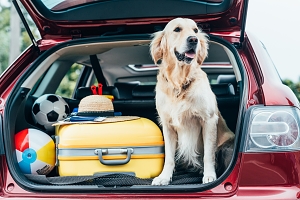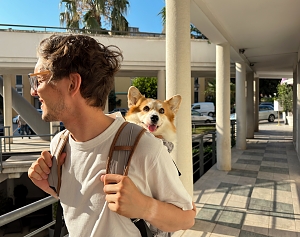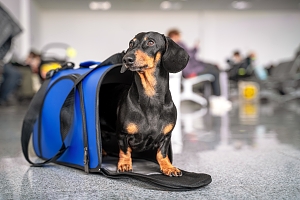As vacations become increasingly inclusive of our four-legged companions, a recent Trip Advisor study reveals that over half of pet owners in the United States prefer bringing their cats and dogs along on their travel adventures. It’s a sentiment shared by those who consider their pets integral family members—why leave them behind when hitting the road?
The positive news is that the travel industry now offers more pet-friendly options than ever before. Hotels and rental homes are adapting to accommodate most pets, ensuring a seamless travel experience. However, even with these expanding choices, a savvy pet owner understands the importance of preparation and follows these tips to optimize the experience of traveling with pets.
Pre-Traveling with Pets Preparation
 While the prospect of traveling with pets is exciting, a poorly planned trip can prove stressful for your furry companions and potentially disastrous for you. Thorough preparation is key, beginning with a consultation with your veterinarian. Discuss your travel plans, ensuring your pet’s overall health and ability to travel safely. Your vet can provide valuable tips, such as potential environmental concerns at your destination. Consider obtaining a microchip for added safety in case of accidental separation during transit.
While the prospect of traveling with pets is exciting, a poorly planned trip can prove stressful for your furry companions and potentially disastrous for you. Thorough preparation is key, beginning with a consultation with your veterinarian. Discuss your travel plans, ensuring your pet’s overall health and ability to travel safely. Your vet can provide valuable tips, such as potential environmental concerns at your destination. Consider obtaining a microchip for added safety in case of accidental separation during transit.
Stock up on gear to ensure your pet’s comfort and well-being during the trip. For driving, assemble an emergency first-aid kit, including essentials like tweezers, gauze, and a strip of fabric for emergencies. Include a spill-proof water bowl for hydration, collapsible bowls for food, and a calming aid to alleviate travel-related stress. Familiar toys or blankets can help keep your pet calm and occupied.
Conduct a trial run to acclimate your pet to longer trips. Gauge their comfort level in a crate or harness and address any potential motion sickness or anxiety issues.
Driving with Your Pets
When it comes to traveling with your beloved pets, hitting the open road may seem like the most comfortable option. The ability to take regular breaks and maintain a familiar environment can significantly contribute to your pet’s well-being. Nevertheless, even within the confines of a familiar vehicle, a lengthy car journey can be a source of stress for your furry companions.
Here’s a detailed guide to ensuring their comfort and safety:
Restraint
Ensuring the safety of your pet during car travel is paramount. Always opt for restraint measures to prevent potential distractions for the driver and to secure your pet in the event of unexpected stops or accidents.
There are various effective options available, including pet seat belts, specially designed car seats, barriers, or travel crates. Choosing the right restraint method depends on your pet’s size, temperament, and your vehicle’s configuration. This not only safeguards your pet but also promotes a focused and undistracted driving experience.
Food and Water
 Maintaining your pet’s well-being during a journey involves planning for their nutritional needs. Even in an air-conditioned car, dehydration can be a concern. Ensure you have an ample supply of fresh water readily available in spill-proof bowls to quench your pet’s thirst during the trip.
Maintaining your pet’s well-being during a journey involves planning for their nutritional needs. Even in an air-conditioned car, dehydration can be a concern. Ensure you have an ample supply of fresh water readily available in spill-proof bowls to quench your pet’s thirst during the trip.
Plan regular stops for bathroom breaks and exercise to allow your pet to stretch their legs, relieve themselves, and stay mentally stimulated. Providing small, easily digestible meals throughout the journey is advisable, preventing any discomfort and promoting a more relaxed travel experience.
Safety Precautions
Warm days can escalate temperatures inside a parked car rapidly, posing serious risks to your pet’s health. Never leave your pet unattended in the car, even with windows cracked, as this can lead to heat-related complications.
Plan your stops accordingly, allowing your pet to accompany you whenever you leave the vehicle. When navigating busy rest stops and picnic areas, always utilize a leash to ensure your pet’s safety. This simple precaution prevents potential accidents and helps maintain control in unfamiliar environments, ensuring a stress-free and secure experience for both you and your furry friend.
When you follow these comprehensive measures, you not only prioritize your pet’s safety and well-being but also transform your road trip into an enjoyable adventure for both of you.
Air Travel with Pets
Air travel requires meticulous preparation, considering that you won’t have contact with your pet during the flight:
 Assessment: Assess whether your pet is fit for flying, considering factors such as age, health, and temperament. Research airlines thoroughly, looking into their safety records and specific regulations.
Assessment: Assess whether your pet is fit for flying, considering factors such as age, health, and temperament. Research airlines thoroughly, looking into their safety records and specific regulations.
Documentation: Gather all necessary documentation, including proof of vaccination, and ensure your pet has an ID tag or microchip.
Carrier Preparation: Prepare the pet carrier by making sure your pet can stand comfortably. Familiarize them with the carrier beforehand, and equip it with spill-proof water containers and familiar bedding or toys.
Pre-Flight Rituals: Before the flight, take your pet for a walk or play with them to help them relax and expend energy. This may encourage them to sleep during the journey, reducing stress.
By adhering to these precautions and preparing in advance, you can ensure successful travels with your pets, fostering a positive experience for both you and your furry companions. If you’re uncertain about your pet’s ability to handle long trips, consider professional pet walking or sitting services as an alternative while you’re away. Traveling with pets is an enriching experience, and with careful planning, it can be a joy for both pet owners and their beloved companions.
Reach Out to Northern Virginia’s Top Pet Sitters
Embark on stress-free travels by choosing Paw Pals Pet Sitting to watch over your furry friend while you’re away. Our dedicated team ensures comprehensive care, backed by Pet Tech Certification for advanced expertise. Whether it’s regular mid-day walks, overnight stays, host sitting and more, our Paw Pals pet sitters will care for your beloved pet as if it were their own.
Contact Paw Pals Pet Sitting today to experience the difference in pet care. Your pets deserve the best, and we’re here to provide it. Travel worry-free, knowing your furry friends are in capable and caring hands.


